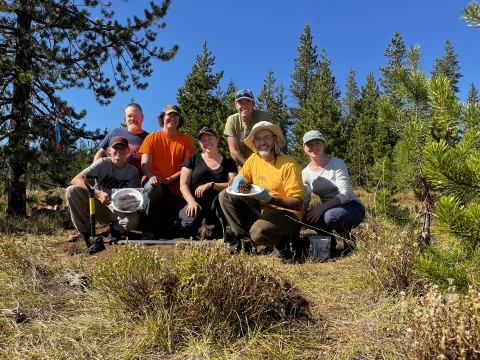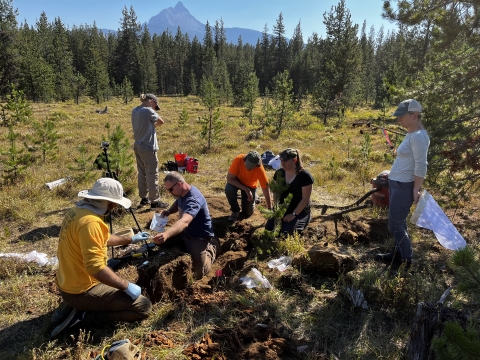By Jan Peterson, for the U.S. Fish and Wildlife Service’s Pacific Region
With its numbers on the decline, the Western bumble bee is elusive. Its nests even more so.
Very few Western bumble bee nests have ever been recorded or collected.
But there is so much information to be gleaned from the crucial pollinator’s underground nests – from preferred habitat to its vulnerabilities – finding them and the information they contain is vital in protecting the bee’s population from further decline.
So last year, the U.S. Fish and Wildlife Service’s Pacific Region Science Applications team convened a group of partners at Tualatin River National Wildlife Refuge, in Oregon, to explore the best methods to find bumble bee nests.
The hope was to better understand bee behavior so they could eventually find a nest to learn more about the bee. What they didn’t expect was to find one so quickly.
Alan Yanahan, a conservation biologist with the Service’s Science Applications program, says spotting any bee’s nest often boils down to luck.
But shortly after the training session, a trio of researchers – with the support of many volunteers, interns and representatives of other agencies – made the discovery of their dreams.
Yanahan; Lincoln Best, a bee specialist at Oregon State University; and Jeff Everett, a biologist at the Service’s Oregon Fish and Wildlife Office, discovered the underground nest in an Alpine meadow high in the Cascade Mountains of north central Oregon
“Finding the nest was pure luck. It was one in a million,” says Everett.
It was Best’s idea to scout that location. He knew quite a few bumble bees buzzed around that area, so it was a calculated risk. “A lot of scientists haven’t had the opportunity to go to a site with a lot of these critters flying around. I have a few sites where they’re quite abundant. So I said, let’s get out there and do some basic training and data collection and then who knows?” Best says.
“We were hiking around and within 20 minutes, Alan and I stumbled across a nest. We saw a worker bee fly down to the ground behind a rabbitbrush bush. Sure enough, it went down a little ground squirrel hole and that was it,” Best recalls of the Aug. 22, 2022, expedition.
Throughout the month of September 2022, scientists kept an eye on the nest for activity.
The concern was they didn’t want to excavate the nest too early. Western bumble bees don’t reuse a nest from year to year, so they wanted to excavate when the colony was winding down for the year but before worker bees had completely abandoned it.
“We got it at the perfect time,” Yanahan says. “The nest had done what it needed to do.”
Next came the fun part: Excavation.
The team wasn’t sure what they would run into, so they brought in everything: heavy tools, hand tools, paintbrushes, coolers of dry ice for preserving samples, even a generator and a shop vac, which turned out to be a crucial tool in the excavation.
It was hot, dirty, time-consuming work.
“This thing went all over the place,” Everett says of the abandoned rodent burrow. After several twists and turns and the discovery of a false cavity, the scientists finally got to the nest.
“The rodent-burrow tunnel was over 2 meters in length – longer than anyone expected. It was another meter vertically down to the nest,” Everett says.
Best took the nest back to the lab for dissection and discovered more than 300 cells, some of which were used to store honey, others for raising their young.
But there is so much more to discover from the nest.
“We want to learn as much from this as possible because there are many ways this will directly inform handling of the species,” Everett explains. “Through honey and pollen analysis, we can promote and protect those resources. We can encourage landowners and our partners to plant specific flowers."
“By understanding the orientation of the nest and the critter that dug all the holes, we can promote those specific habitats. Protecting and preserving can take many forms. It’s not putting up a fence. It’s limiting the threats and promoting well-being.
“There’s a lot about bumble bees that we fundamentally don’t know. There were literally hundreds of abandoned rodent burrows. What makes this one (created by the golden mantled ground squirrel) more attractive than all the others out there?”
Yanahan says, “What we learn from this species is transferable to other bee species. What we learn here as far as being able to find nests can lead to finding nests for other species.”
What scientists learn from the Western bumble bee’s nest may help other bumble bees whose populations are perilously low. Among them are Morrison’s bumble bee, Suckley’s cuckoo bumble bee and Franklin’s bumble bee, the latter not seen in more than 15 years.
While environmental factors are cause for concern, scientists also suspect disease may be one of the reasons bees are on the decline.
“There are a bunch of different bumble bees that have measurably declined. While we have some smoking guns, we haven’t been able to pin it on any of the intuitive culprits. If we can find evidence of active disease, that might help inform management decisions.” OSU’s Best says.
Tests on the nest are expected to continue, with results rolling in throughout the course of the next year.
“It’s a cool adventure,” Best says.
America loves its wildlife, both domestic and international, and that love of wild things and wild places helps define our character as a nation. We and our state partners face mounting pressures on the species we are entrusted to manage from threats such as habitat loss, climate change climate change
Climate change includes both global warming driven by human-induced emissions of greenhouse gases and the resulting large-scale shifts in weather patterns. Though there have been previous periods of climatic change, since the mid-20th century humans have had an unprecedented impact on Earth's climate system and caused change on a global scale.
Learn more about climate change , wildlife disease and invasive species invasive species
An invasive species is any plant or animal that has spread or been introduced into a new area where they are, or could, cause harm to the environment, economy, or human, animal, or plant health. Their unwelcome presence can destroy ecosystems and cost millions of dollars.
Learn more about invasive species . Urgent action now can help the American people heal, minimize species decline, avert catastrophic invasive species takeover, build a more climate-resilient future, and address systemic exclusion of underrepresented people in wildlife conservation.





